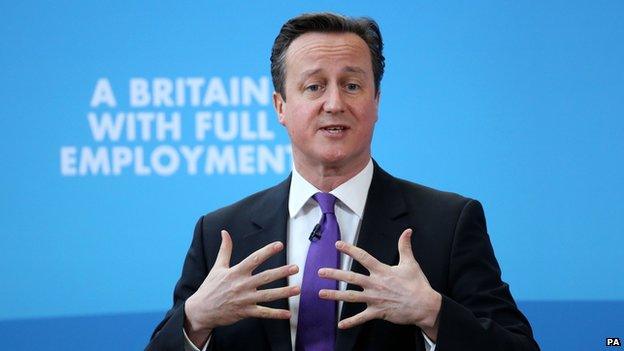Headline numbers: Targeting employment or unemployment
- Published

Official figures on Tuesday told us that the employment rate was at about 73.0% while that for unemployment was at about 5.8%.
Both of these figures, external follow the continuing trend of employment rising and unemployment falling.
But clearly they do not add up to 100%, and there have been discussions this week about which number the government should be targeting.
On Monday, Prime Minister David Cameron said he was committed to achieving full employment, by which he meant taking the UK's employment rate above those of other developed countries.
That's quite an unusual definition of full employment, which is usually taken to mean getting unemployment down to a rate at which it does not cause inflation, which is often given as 5%.
In August 2013 when the Bank of England was looking for a measure of the economy to target as part of its forward guidance policy, it said that it would not consider raising interest rates until the unemployment rate was below 7%.
What is the difference between targeting employment and unemployment?
The employment rate is the proportion of all people aged between 16 and 64 who are in work.
The unemployment rate is the number of people who are unemployed divided by the economically active population, which is the number of people employed plus the number of people unemployed.
Hence, what makes the difference between the two figures is the economically inactive population, which is people who are not looking for work or not available for work.
That includes people in full-time education or training, people unable to work as a result of illness or disability, people with caring responsibilities such as those looking after young children and people who have taken early retirement.
So the reason the employment rate and the unemployment rate don't add up to 100% is the nine million or so economically inactive people between the ages of 16 and 64.
The other difference is that the employment rate only covers those aged between 16 and 64, while the unemployment rate does not have an upper age limit.
The Institute for Public Policy Research did some research, external funded by the Trades Union Congress in July 2013 on which target should be used.
Strange situation
It concluded that the employment rate was a better one to target and added that a rate of 73% was consistent with an unemployment rate of about 5% - but either target throws up anomalies.
If you are targeting unemployment, then you can cut the rate by persuading more people to move from unemployment to inactivity by giving up on looking for a job or returning to education or training, for example.
This creates the strange situation in which, when an economy recovers from a downturn, there may be a temporary rise in unemployment as inactive people decide it may be worth starting to look for a job again.
If you're targeting employment, then that is no longer an issue, but there is still a problem that, for example, for the government target, it is better to have two people working 20 hours a week (even if they want more work) than to have one person working 40 hours a week. But that may not be the best thing for the economy.